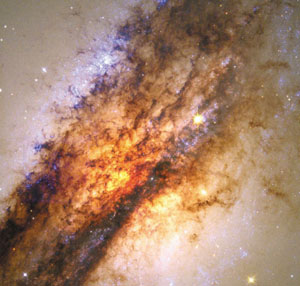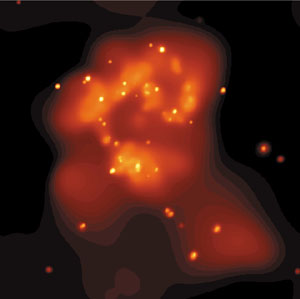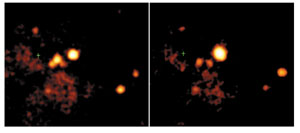Part two of Astrowatch’s coverage of the meeting of the
International Astronomical Union in Manchester:
Emma Sanders reports on new studies of active
galaxies and the latest innovative instrumentation.
Today’s telescopes allow astronomers to probe deep into
the active inner regions of galaxies and see far back in time
to the periods of momentous upheaval in the early
universe. At this year’s International Astronomical Union
(IAU) conference in Manchester, attention focused on new
high-resolution studies of some of the most energetic
objects known to exist.
Around a billion years ago,
at a redshift of about 5, the first galaxies started to
agglomerate. They were very different from the galaxies
we see around us today.
During this period of
intense activity, quasars released extraordinary amounts of
energy into the interstellar medium, outshining galaxies of
hundreds of billions of stars. These quasi-stellar objects are
thought to be associated with the growth of big black
holes in the inner parts of the first galaxies. Quasar activity
is seen to peak at a redshift of around 3 – the same time at
which bulges start to form in the centres of spiral
galaxies.


Extra-galactic black holes
“The most
convincing information about black holes comes from
water maser emission in the surrounding accretion disks,”
said Martin Rees of Cambridge. Maser microwave
emission also comes from OH and CH2O
(formaldehyde) present in the disk, which is pumped by
the far infrared emission. The masing allows astronomers
to detect the transverse motion of material orbiting the
black hole and to calculate the mass and density of the
central region. We now know of 21 such
megamasers.
Last May’s meeting of the
International Telecommunications Union provided good
news for astronomers, as proposals were adopted to
protect maser wave bands from radio pollution from
mobile phone networks (March p11).
Dayton Jones
of Caltech presented a radio image of the centre of galaxy
NGC6241, showing two jets projecting outwards from the
centre, as is common in such active galaxies. However,
Jones has observed a gap in the jets that he believes is
caused by absorption from the accretion disk of gas and
dust orbiting the central black hole. The gap matches up
with an optical image of the accretion disk taken using the
Hubble Space Telescope (HST). The fact that different
wavelength observations can be matched up in this way is
a step forward in the understanding of black
holes.
Radio observations of gas movement in the
centres of galaxies and spectral line data from the HST
suggest that super-massive black holes exist in the centre
of every galaxy. “So why aren’t more galaxies active?”
asked John Conway of the Onsala Space
Observatory.
With advances in interferometry
instrumentation and techniques, studies of active galactic
nuclei (AGN) have dramatically improved over recent
years. Roeland Van der Marel of the Space Telescope
Science Institute stressed the importance of bar structures
in spiral galaxies that encourage gas to flow into the
centre, feeding star formation. He believes that many AGN
are hidden by dust and will only be revealed as
observations at other wavelengths improve. “With X-ray
imaging now advancing, it will be interesting to see how
much obscure AGN activity is actually going on,” he
said.
Sagittarius A*
The nearest black hole is
in the centre of our galaxy, the Milky Way. It lies in a
region of high activity known as Sagittarius A*. Recording
the movements of the stars in orbit around Sagittarius A*
shows that the central black hole is 3 million times heavier
than the Sun.
In the summary of the session on
galaxies and their components at high-angular resolution,
Peter Wilkinson of Jodrell Bank looked at what future
telescopes will reveal. The Large Binocular Telescope
being built by Italy, the US and Canada should record the
orbits of individual stars close enough to measure whether
general relativistic effects come into play. Does the black
hole act as a point source mass (relativistic) or as a
distributed mass (non-relativistic)? Using today’s Very
Long Baseline Interferometry (VLBI) radio observations,
we can see Sagittarius A* down to 15 times the effective
size of the black hole (Schwartzchild radius). “By the end
of the decade, sub-millimetre VLBI will be able to image
the event horizon of the black hole,” said
Wilkinson.


New X-ray observations
“What is
new at this conference is that for the first time we have
comparable resolution between radio and X-ray,” said
Rees. Indeed, with the launch of two new X-ray satellites,
astronomers are spoilt for choice (April p11).
In
Manchester, X-ray images from NASA’s Chandra satellite
stole the show. The new results were presented by
Guiseppina Fabbiano of the Smithsonian Astrophysical
Observatory. “For the first time, we have sub-arcsecond
resolution in conjunction with spectral resolution,” she
said.
X-rays are emitted by the hottest, most
energetic regions of the universe. Fabbiano gave a
run-down of the impressive range of observations now
possible, including new estimates of the baryonic content
of the universe, measures of the elemental composition of
stars from supernova remnants, and a new perspective on
the evolution of galaxies.
Observations of the
antennae galaxies, colliding galaxies with streams of
material emanating from their core, reveal huge bubbles of
hot gas at X-ray wavelengths, and provide an example of
conditions when our universe was young and galaxies
were forming. “This is just the beginning,” said
Fabbiano.
Starburst galaxies
Andrea
Prestwich of Chandra showed new X-ray images of
starburst galaxies. M82 is particularly bright in the X-ray
region, emitting a total of 1042 ergs/s. What
was previously detected as X-ray background emission can
now be resolved into point sources. Alan Pedlar of Jodrell
Bank told the conference how radio images of the
supernovae in M82 can be used for studies of the star
formation rate and as a probe of the interstellar medium
(February 1999 p9).
Much interest was generated
by attempts to match up the X-ray sources with radio
counterparts. The strongest X-ray source has no radio
counterpart. The flickering of the source and its high
luminosity are strong evidence that the X-rays are
produced by matter accreting onto a black hole with a
mass more than 500 times that of the Sun (see
above).
Future instrumentation
Richard
Schilizzi, director of the European VLBI network and
chair of the symposium on galaxies and their components
at high-angular resolution, told CERN Courier that
his aim had been to bring together people from different
wavelength ranges who work on the same things but who
are perhaps not fully aware of what the others are doing.
“It’s been a real showcase of the latest experiments,” he
said. He was particularly enthusiastic about the many
presentations on new instrumentation: “There are plans
right across the spectrum, it really is
fantastic.”
During the meeting, astronomers from
Europe, the US, Asia and Australia signed an agreement
to plan a huge new radio telescope, the Square Kilometre
Array. Construction is scheduled to begin in 2010 and the
finished telescope should give milli-arcsecond resolution,
with a collecting area 50-100 times larger than existing
radio interferometers.
In infrared, ALMA (Atacama
Large Millimeter Array) will bring equivalent resolution,
with 64 12 m diameter antennae to be built over a 10 km
area in Chile.
“What was completely new to me was
the presentation on X-ray interferometry,” said Schilizzi.
“Gamma ray was a real eye-opener too – that Bragg
diffraction crystals could give milli-arcsecond resolution at
gamma-ray wavelengths.”
At the start of a new
millennium, astronomy is poised for a big leap forward in
instrumentation across the whole electromagnetic
spectrum. The future lies in combined multi-wavelength
observations, which are set to provide new perspectives on
the many fundamental questions waiting to be answered:
How much mass is there in the universe? What is dark
matter? How did large-scale structure form? How did
galaxies form? Are there any pockets of antimatter left in
the universe? What physical processes are behind the
prodigious amounts of energy released in gamma-ray
bursts? Does this have anything to do with high-energy
cosmic rays? It’s an exciting time to be working in the
field.

Astronomy in Manchester
Manchester
University, founded in 1851, was a fitting venue for this
year’s IAU conference. For nearly 50 years, the
university’s Jodrell Bank Observatory has been at the
forefront of radio astronomy. The site is now headquarters
for the MERLIN radio telescope network which pioneered
high-resolution studies of galaxies. The network has a
resolution of at least 50 milli-arcseconds, better than the
HST.
The linchpin of MERLIN, the 76 m steerable
Lovell radio telescope, named after Jodrell Bank’s founder
Sir Bernard Lovell, is undergoing a £2 million upgrade
which is due to be completed by the end of 2002. This will
allow the telescope to operate in a higher frequency range
and will more than double its sensitivity.
Astroparticle physics
“Astronomers are
looking to establish new collaborations with research labs
such as CERN and Fermilab,” the new president of the
IAU Franco Pacini told CERN Courier. Pacini is a great
believer in the importance of increasing the ties between
particle physics and astronomy. He points to many key
areas of research that will benefit from combined efforts.
“Neutrino experiments are getting bigger and bigger,” he
said. “Many physicists are already involved in gamma-ray
astronomy.” The two communities should share
knowledge of new advances in detector technology, and
the organization of large experiments.
Research into
fundamental cosmological values and the formation and
evolution of stars will also benefit from new collaborations.
“Dark matter was discovered by astronomers,” Pacini
added. “Now, to find out what it is, is up to the physicists.”
The IAU is setting up a working group on particle
astrophysics within its division on high-energy
astrophysics. He promised that by the next IAU meeting,
in Sydney in 2003, the working group will be in place and
more joint projects will be underway.








